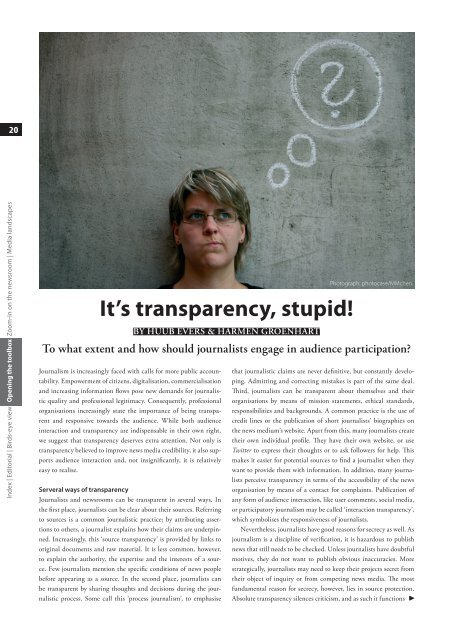MediaAcT
How fragile is media credibility? Accountability and transparency in journalism: research, debates, perspectives Final Research Report | Media Accountability and Transparency in Europe
How fragile is media credibility? Accountability and transparency in journalism: research, debates, perspectives
Final Research Report | Media Accountability and Transparency in Europe
Create successful ePaper yourself
Turn your PDF publications into a flip-book with our unique Google optimized e-Paper software.
Index | Editorial | Birds-eye view | Opening the toolbox toolbox|<br />
Zoom-in on the newsroom | Media landscapes<br />
0<br />
it’s transparency, stupid!<br />
Journalism is increasingly faced with calls for more public accountability.<br />
Empowerment of citizens, digitalisation, commercialisation<br />
and increasing information flows pose new demands for journalistic<br />
quality and professional legitimacy. Consequently, professional<br />
organisations increasingly state the importance of being transparent<br />
and responsive towards the audience. While both audience<br />
interaction and transparency are indispensable in their own right,<br />
we suggest that transparency deserves extra attention. Not only is<br />
transparency believed to improve news media credibility, it also supports<br />
audience interaction and, not insignificantly, it is relatively<br />
easy to realise.<br />
Serveral ways of transparency<br />
Journalists and newsrooms can be transparent in several ways. In<br />
the first place, journalists can be clear about their sources. Referring<br />
to sources is a common journalistic practice; by attributing assertions<br />
to others, a journalist explains how their claims are underpinned.<br />
Increasingly, this ‘source transparency’ is provided by links to<br />
original documents and raw material. It is less common, however,<br />
to explain the authority, the expertise and the interests of a source.<br />
Few journalists mention the specific conditions of news people<br />
before appearing as a source. In the second place, journalists can<br />
be transparent by sharing thoughts and decisions during the journalistic<br />
process. Some call this ‘process journalism’, to emphasise<br />
By huuB eVerS & hArMen grOenhArT<br />
Photograph: photocase/MMchen<br />
To what extent and how should journalists engage in audience participation?<br />
that journalistic claims are never definitive, but constantly developing.<br />
Admitting and correcting mistakes is part of the same deal.<br />
Third, journalists can be transparent about themselves and their<br />
organisations by means of mission statements, ethical standards,<br />
responsibilities and backgrounds. A common practice is the use of<br />
credit lines or the publication of short journalists’ biographies on<br />
the news medium’s website. Apart from this, many journalists create<br />
their own individual profile. They have their own website, or use<br />
Twitter to express their thoughts or to ask followers for help. This<br />
makes it easier for potential sources to find a journalist when they<br />
want to provide them with information. In addition, many journalists<br />
perceive transparency in terms of the accessibility of the news<br />
organisation by means of a contact for complaints. Publication of<br />
any form of audience interaction, like user comments, social media,<br />
or participatory journalism may be called ‘interaction transparency’,<br />
which symbolises the responsiveness of journalists.<br />
Nevertheless, journalists have good reasons for secrecy as well. As<br />
journalism is a discipline of verification, it is hazardous to publish<br />
news that still needs to be checked. Unless journalists have doubtful<br />
motives, they do not want to publish obvious inaccuracies. More<br />
strategically, journalists may need to keep their projects secret from<br />
their object of inquiry or from competing news media. The most<br />
fundamental reason for secrecy, however, lies in source protection.<br />
Absolute transparency silences criticism, and as such it functions


